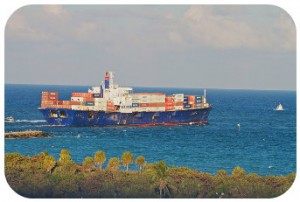 Almost 95 percent of all manufactured goods arrive at their destinations in shipping containers. These freight boxes often begin their journeys aboard enormous cargo ships that transport items around the globe. Normally this process is simple enough: a ship pays a docking fee upon arrival along with additional charges for unloading and container storage. In the case of South Korea’s Hanjin Shipping Company, however, this common process has been halted. After filing for bankruptcy protection last week, ports across the world are turning away ships owned by the embattled corporation, leaving some $14 billion in merchandise stranded at sea.
Almost 95 percent of all manufactured goods arrive at their destinations in shipping containers. These freight boxes often begin their journeys aboard enormous cargo ships that transport items around the globe. Normally this process is simple enough: a ship pays a docking fee upon arrival along with additional charges for unloading and container storage. In the case of South Korea’s Hanjin Shipping Company, however, this common process has been halted. After filing for bankruptcy protection last week, ports across the world are turning away ships owned by the embattled corporation, leaving some $14 billion in merchandise stranded at sea.
Along with the unfortunate crews of these idle ships, the stall presents a major headache for companies who can’t retrieve their goods. Samsung, for instance, says that it has as much as $38 million worth of cargo stranded on Hanjin ships. “We’re passengers on a bus, and we’re being told we can’t get off,” said a lawyer for the telecom company. Samsung executives are considering charting 16 planes in order to grab their items and fulfill their shipping contracts. But while major corporations can afford expensive interventions like this, smaller companies have no such luxury. For these firms, the Hanjin shipping stall could have devastating effects on their bottom lines.
For the moment, though, analysts don’t think the disruption will harm retailers too much as they stock up for the holiday season. “This is not impacting store shelves now,” said a senior vice president for American Apparel and Footwear Association. “It will impact store shelves if the situation isn’t resolved.” At least 10 European and Asian ports are discounting their unloading fees for ships with Hanjin cargo, amounting to about $1,260 per container. The Korean government has also designated the ports of Los Angeles, Singapore and Hamburg as zones where Hanjin can offload goods without fearing that they’ll be seized by creditors. Still, these relief efforts leave a number of other problems unaddressed. “Even in those ports, we don’t know who is going to be paying unloading and docking fees,” said a broker in Singapore. “Korea says it will be Hanjin, but Hanjin is telling us it has no money. It’s a total mess.”
Questions:
- How do disruptions like Hanjin Shipping’s bankruptcy affect global supply chains?
- Why are smaller firms more likely to be harmed by supply chain stalls than larger companies?
Source: Costas Paris and Erica E. Phillips, “Hanjin Shipping’s Troubles Leave $14 Billion in Cargo Stranded at Sea,” The Wall Street Journal, September 7, 2016. Photo by Michael Bentley.
